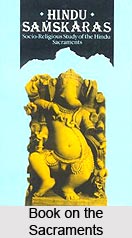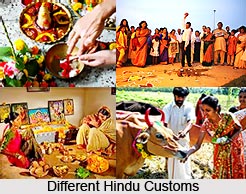 The spiritual grace of India and its cordial traditions are well preserved in the Sacraments or religious books of this country with rich heritage. These books reflect the actual religious life of the Hindus. Although the present day practices show that the Hindus are deviating from the principles mentioned in the sacred works, but it is also factual that many dedicated individuals and pious minded still carefully maintain the religious character of their household.
The spiritual grace of India and its cordial traditions are well preserved in the Sacraments or religious books of this country with rich heritage. These books reflect the actual religious life of the Hindus. Although the present day practices show that the Hindus are deviating from the principles mentioned in the sacred works, but it is also factual that many dedicated individuals and pious minded still carefully maintain the religious character of their household.
The Hindu rituals or the Hindu Sacraments are regarded as an integral part of Dharma and the aim of Dharma is to develop the individual in every aspect. These sacraments help the individual to achieve the spiritual goals in his life and attain merit even during his regular schedule. The person believing truly in sacraments not only involves himself in the worldly life, but also establishes a balance between materialistic affairs and spiritual aspirations.
The form and number of sacraments are varied. According to Greha Sutra, there are 11 sacraments; while Gaytam Dharma Sutra says that 40 sacraments exists. The Vaikhanasa numbers them as 18; whereas Smriti Chandrikfi follows the fact of 16 sacraments. The ancient domestic rules or Greha Sutras and in the Code of Manu, twelve rites for purification is called Sanskaras or Sacraments. These rites were approved for the purification of a man in all aspects; such as body, soul and spirit. Some of the important sacraments are as follows:
1. Garbhadana or Garbha-Lambhana: Impregnation is the first sacrament, which is followed immediately after every matrimonial union. In ancient times, the bridegroom approached the bride after the fourth night of their marriage ceremony. On the day before, the bride and the bridegroom purify their bodies of ablutions and then the bridegroom approaches his wife. This act brings another human being into the world and the bridegroom repeats two mantras. This sacrament however, in modern times is considered as merely a physical act and has lost its religious purity.
2. Pumsavana or Punsavan: This rite was followed after three months of the Impregnation Rite. This rite was performed for the birth of a handsome, strong, male child. According to Vedic texts, the rite was performed when the husband prayed along with his wife. During this sacrament the wife fasts and wear new clothes. The happiness of the parent`s soul after their death is said to be depending on the dutiful performance of the Shraddha ceremonies by the son. The son is also legible of the family possessions after his parent`s death. A son is considered as the first and last of all necessary wishes of every Hindu couple. With the advent of modern family planning and flexible laws of Hindu inheritance, the craving for a son, has declined; but still its importance has not been diminished.
Another additional rite Anavalopna or (Anavalobhana) is performed for the prevention of miscarriage. This ritual was performed by sprinkling the juice of a Durba grass in the wife`s right nostril, with the repetition of some particular mantras. This rite is no more into practice.
3. Seemantonnyan or Hair Parting: This Hindu ritual or sacrament is performed in the fourth month of pregnancy. This sacrament starts with the prayer to fire and Vedic texts repeated by the priests. The woman then performed her rites in pure water; while fragrant oil was poured slowly on her head and a line or parting or Simanta was drawn three times along her hair from the forehead. This line ran upwards with three stalks of Kusa grass tied together. Three sacred words known as vyahritis (combination of Bhur, Bhavar, Svar) made the hallowed sound of OM (AUM) during each operation. The idea of this sacrament was that the body of the mother was sanctified and protected from any other evil influences at the vital period of gestation. This rite was only performed for the first pregnancy.
4. Jath Karman or Birth Ceremony: The father performs this sacrament or sanskara after the birth of the child and just before the severing of the umbilical cord. Honey and ghee is mixed together, stirred by a golden spoon and a small portion of the mixture is poured into the mouth of the newborn infant. This rite symbolizes good fortune.
5. Num Karan or Nam Karana - Name giving: Giving a name to the baby is a solemn religious ceremony among the Hindus. The given name is believed to bring important consequences after its bearing on the future scenario of the infant. Asvalayasa laid down the sound and meaning of a particular name given. The name of a boy usually follows the form of two, four or even syllables and also bear a soft consonant for the first letter and a semi vowel in the middle. The female names are usually soft, clear, captivating, auspicious and ending in lengthy vowels. This sacrament is carried out on the 10th or 11th day of the birth of the child. On this occasion, food is offered to the Brahmin.
6. Nishkramana or Carrying Out: During this sacrament, the child is taken out of the house for the first time. This sacrament is also called "Darshan` because the child is and is made to look at the Sun. The parents perform this rite after four months of the birth of the child.

7. Anna Prasana or Food Giving: This happens to be a very popular and important sacrament in the Hindu household and is more or less still in practice. This rite is performed in the sixth month of the birth of the child. The father holds the child amongst his relatives and friends, where the family priest offers prayers for the well being of the child. The invitees bring gifts for the baby. Now that the child can consume solid food, the father or the maternal uncle of the child feeds the child. Usually rice cooked in milk or Kheer is given to the child. In Bengal, this dish is known Pias. After this, the child is ritually ready to consume solid food.
8. Choodil Karan or Tonsure, Shaving, Cutting of the hair: The first tonsure of a child is an essential rite, however, it is known by varied names and distinguished in various ways by different castes and regions. In the southwest, this sacrament is known as the Jhand and in other places as the Mundan or Bhaddan. If the mother had sworn prior to the birth of the child to perform the rite at a certain shrine or temple, this rite is carried out there; otherwise it is also done at home.
A Brahmin allots an auspicious hour and the child`s hair is shaved. It is unlucky to shave a child`s head, until this sacrament is carried out. The performance of this sacrament increases happiness, good fortune and positive power within the child as says the Vedic texts. This sacrament is usually performed in between the end of the first and the third year after the birth of the child.
Among Sikhs, this rite is uncommon, as they never allow a girl`s hair to be cut. However, if it is observed, it is done when the child is only two or three months old. In wealthy families, the rite is the grand occasion for a feast to BrShmirts, otherwise they are not involved in this sacrament. This sacrament is also known as the Caula, Cuda-Karma, Kesanta or Kshaur. Due to its purifying effect on the character of the child, this rite is performed on a grand basis in most of the households for the first time.
9. Kama Bheda or Ear Boring: This is the ear-piercing sacrament done to the child for the first time at three or five years of age. This rite is known as a vital religious rite, and usually takes place after the tonsure or cutting of the hair. Greh Sutras do not declare this rite, while Paraskara made it a sanskar, but again Asvalayana or Gobhila do not mention this sacrament. The boy after eating some sweet dish with honey sat facing the direction towards the east. Two perforations were made in his right ear and a particular hymn from the Sama Veda was recited. A similar operation is then performed on the left ear. This sacrament allows the child to wear ornaments, as it was seen on the ears of the rajas, maharajas and wealthy people.
10. Upanayana or Initiation: Upanayan means introducing a boy to his guru or spiritual leader. Until the boy is brought to his spiritual leader, he cannot put on the sacred thread and he also could not be reckoned among the "twice borns" or Dvija. So a sacrament called Vidyarambha or start of education was performed to start the education of the child. In this sacrament, the child first takes a bath and then goes to the guru for getting acquainted with the letters. After this initiation comes the sacrament of Upanayana is essential that determines the social status of the individual.
Upanayana is performed at the age of eight or may be postponed till the age of sixteen. After the boy has been invested with the sacred thread, he is entitled as Dvija or twice born. The Brahmins, Kshatriyas and Vaishyas are called Dvijas, because they undertake the sacrament of initiation. According to Hindu Dharma Shastras, a man is actually shudra by birth, but after the sacrament of Upanayana, he becomes a Dvija. All Hindus are divided into two categories - Dvijas and Shudras, though initiation sacrament is not allowed for shudras.
If a Brahmin want to become a scholar in the Vedas, he should wear the Janeo at the age of five years and if a Kshatriya desires to gain strength, he should tie the Janeo knot at six, and for the Vaishyas, it is in the eighth year of age.




















